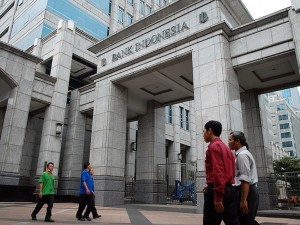Bank Indonesia to Raise its Benchmark Interest Rate to 4.75 Percent
 Bank Indonesia (BI) Board of Governors Meeting (RDG), chaired by Governor of BI Perry Warjiyo, in Jakarta on Wednesday (30/5), decided to raise 3 (three) components: BI 7-Day Reverse Repo Rate by 25 bps to 4.75% from the previous 4.50%, Deposit Facility (DF) interest rate by 25 bps to 4.00%, and the Lending Facility (LF) rate by 25 bps to 5.50%.
Bank Indonesia (BI) Board of Governors Meeting (RDG), chaired by Governor of BI Perry Warjiyo, in Jakarta on Wednesday (30/5), decided to raise 3 (three) components: BI 7-Day Reverse Repo Rate by 25 bps to 4.75% from the previous 4.50%, Deposit Facility (DF) interest rate by 25 bps to 4.00%, and the Lending Facility (LF) rate by 25 bps to 5.50%.
This decision is effective since May 31, 2018, said Executive Director of BI Communication Department, Agusman, in a press release Wednesday (30/5).
According to Agusman, the decision to raise interest rates was to strengthen exchange rate stability against higher US interest rate hikes, and the rising risks in global financial markets.
Bank Indonesia, Agusman emphasized, believes the overall economic condition of Indonesia is quite good and strong. Pressures on stability since early February are more likely caused by US interest rate hikes and the increasing global uncertainty due to US policy changes and geopolitical risks.
The decision is part of the short-term policy by Bank Indonesia, which prioritizes monetary policy on stability, especially for Rupiah exchange rate, Agusman wrote.
He also mentioned other short-term measures taken by BI in maintaining rupiah exchange rate, such as:
First, interest rate policy response will be carried out pre-emptively, front-loading and ahead of the curve for Rupiah exchange rate stabilization, while remain consistent to keep 2018-2019 inflation on target by 3.5±1%.
Second, dual intervention in foreign exchange market and Government Securities (SBN) continues to be optimized in order to stabilize Rupiah exchange rate, to fairly adjust prices in financial markets, and maintain adequate liquidity in money market.
Third, monetary operation strategy is directed to maintain liquidity adequacy especially in Rupiah money market and interbank swap market.
Fourth, intensive communication, especially to market players, banks, businesses, and economists to form a rational expectation that can mitigate the tendency of the overshooting exchange rate compared to the fundamental level.
Agusman stressed that pressures on stability, especially to Rupiah exchange rate, are caused by US policy changes which affect all countries, including Indonesia.
Agusman does not deny that the improving economy and rising inflation in the US will boost the Fed’s interest rate, which expected by a number of financial market participants to increase aggressively up to 4 times higher this year.
The higher increase of interest rate is also caused by the US Government’s fiscal deficit that is expected to reach about 4% of GDP this year and 5% by 2019, Agusman explained.
Both changes in US policy, continued Agusman, have triggered rising yields on US Treasury Bond and the strengthening of the US Dollar against almost all global currencies. Tensions between US and China, as well as some regional geopolitics also have raised global uncertainty.
These global factors have triggered capital outflow and put pressure on financial markets in developed countries and EMEs, including Indonesia, both in the declining of stock prices, the rising bond yields and the weakening of exchange rate against the US dollar, Agusman further explained.
Strong enough
Indonesia’s economy, according to Agusman, at the moment shows strong resilience to external pressures as shown in earlier global pressure periods.
The overall economic condition of Indonesia is quite good as shown by monthly RDG assessment from 16-17 May 2018, said Agusman while pointing to inflation rate which is quite low and under control at target range of 3.5 ± 1%.
In addition to that, economic growth remains modest due to increasing investment in both construction and non-construction projects. The current account deficit has improved from the previous quarter and for the whole 2018 is expected to be under 2.5% of GDP. The stability of financial system is also maintained since credit distribution is improving. (Depkom BI / ES) (STU/MMB/Naster)








